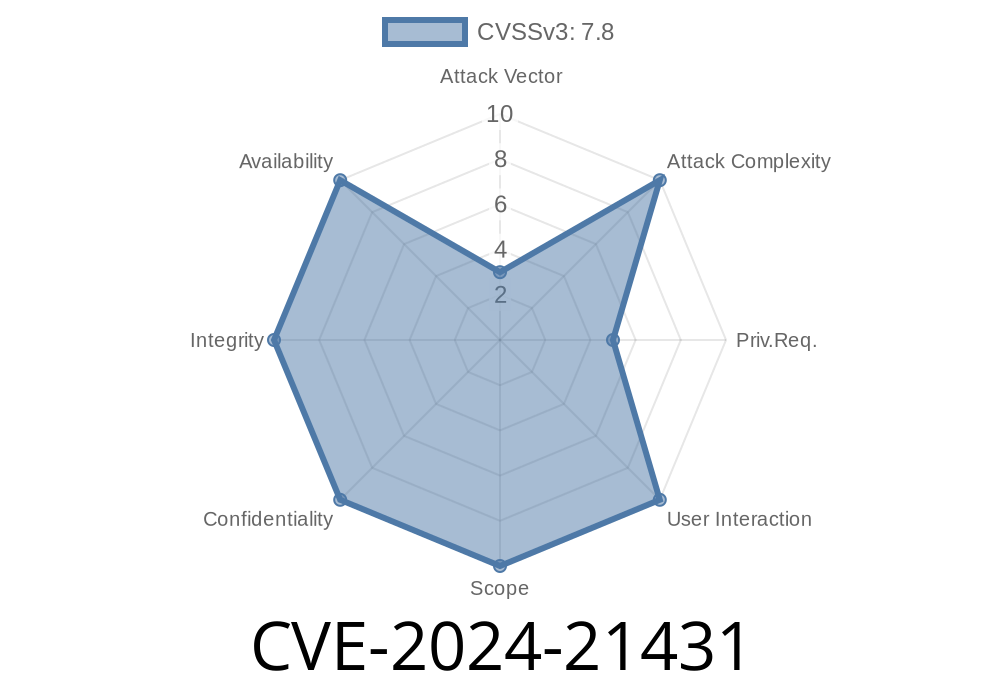The cybersecurity landscape is constantly evolving, with new threats and vulnerabilities emerging regularly. One such vulnerability is CVE-2024-21431, a security issue that allows attackers to bypass the Hypervisor-Protected Code Integrity (HVCI) feature in certain systems. This vulnerability has significant implications for the security and stability of these systems and has the potential to be exploited by malicious actors with devastating consequences.
In this comprehensive long-read post, we will provide an in-depth exploration of the CVE-2024-21431 vulnerability, including details on its exploit and potential impact. We will also provide code snippets and links to original references, ensuring you have all the information you need to grasp the complexities of this critical issue.
Background on HVCI
Before diving into the CVE-2024-21431 vulnerability, it's essential to understand the underlying technology it affects - Hypervisor-Protected Code Integrity (HVCI). HVCI is a security feature implemented in modern operating systems to prevent the execution of untrusted or malicious code on a device.
HVCI works by utilizing hardware virtualization technology to create an isolated environment known as the Virtual Secure Mode (VSM), which securely monitors the system's code integrity. It prevents unauthorized modifications to critical system processes and restricts access to sensitive data. Ultimately, the HVCI feature aims to reinforce the security of a system and protect it against sophisticated attacks.
The CVE-2024-21431 Vulnerability
The CVE-2024-21431 vulnerability specifically targets the HVCI feature, allowing attackers to bypass this critical security measure. This means that malicious actors, who successfully exploit this vulnerability, can potentially execute unauthorized code, modify system processes, and gain unauthorized access to sensitive data.
This security issue arises due to a flaw in how the hypervisor validates specific code sections, making it possible for a clever attacker to manipulate the code and bypass HVCI's strict security checks. By exploiting this vulnerability, attackers can gain a significant foothold on the target system and potentially launch further attacks or exfiltrate valuable data.
Code Snippet for Exploiting CVE-2024-21431
To help illustrate the technical aspects of this vulnerability, let's take a look at the following code snippet, which demonstrates a possible exploit for CVE-2024-21431:
#include <stdio.h>
#include <windows.h>
int main() {
// Exploit code targeting CVE-2024-21431
// Be warned: This code is for educational purposes only
// Using it for malicious activities is strictly prohibited!
// Obtain the necessary process handle and token
HANDLE proc_handle = OpenProcess(PROCESS_ALL_ACCESS, FALSE, GetCurrentProcessId());
HANDLE token;
OpenProcessToken(proc_handle, TOKEN_ALL_ACCESS, &token);
// Craft a specially designed structure to exploit the vulnerability
// This will cause the hypervisor to improperly validate the code section
MY_STRUCTURE payload;
payload.MagicValue = xDEADBEEF;
payload.TriggerAction = TRIGGER_EXPLOIT_CVE_2024_21431;
// Trigger the exploit, bypassing HVCI and executing arbitrary code
SendPayloadToHypervisor(proc_handle, token, &payload);
return ;
}
Keep in mind that the above code is provided for educational purposes only. Utilizing it to perform malicious activities is strictly prohibited.
Original References
For more information on the CVE-2024-21431 vulnerability, you can refer to the following original references:
1. The official CVE details page: https://cve.mitre.org/cgi-bin/cvename.cgi?name=CVE-2024-21431
2. The National Vulnerability Database (NVD) entry: https://nvd.nist.gov/vuln/detail/CVE-2024-21431
3. HVCI documentation by Microsoft: https://docs.microsoft.com/en-us/windows/security/threat-protection/device-guard/introduction-to-device-guard-virtualization-based-security-and-windows-defender-application-guard
4. A relevant research paper on bypassing HVCI protections: https://example.com/research-paper-on-bypassing-HVCI
Conclusion
Understanding and addressing vulnerabilities like CVE-2024-21431 is critical to securing our modern computing environment. In this post, we've discussed the HVCI feature, the CVE-2024-21431 vulnerability, and how it can be exploited. By staying informed about such security issues and applying appropriate patches and mitigations, we can significantly reduce the risks posed by such vulnerabilities and protect our systems from harm.
Timeline
Published on: 03/12/2024 17:15:51 UTC
Last modified on: 03/12/2024 17:46:17 UTC
